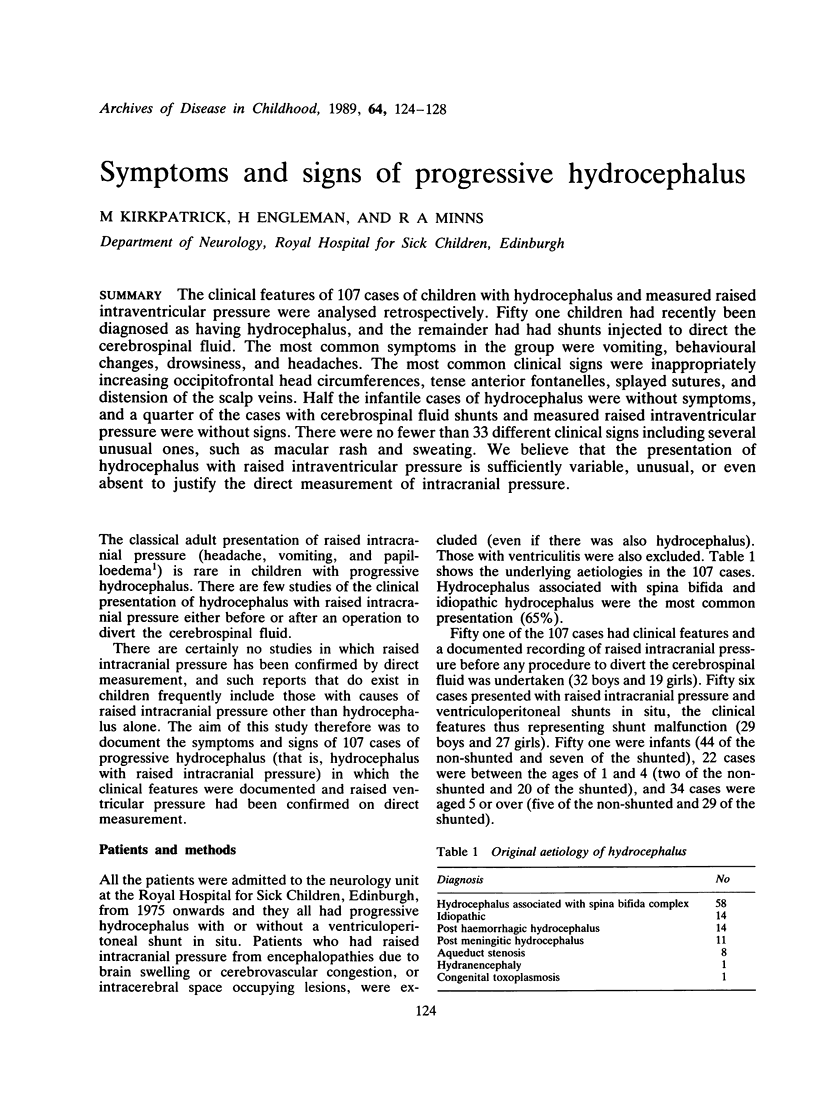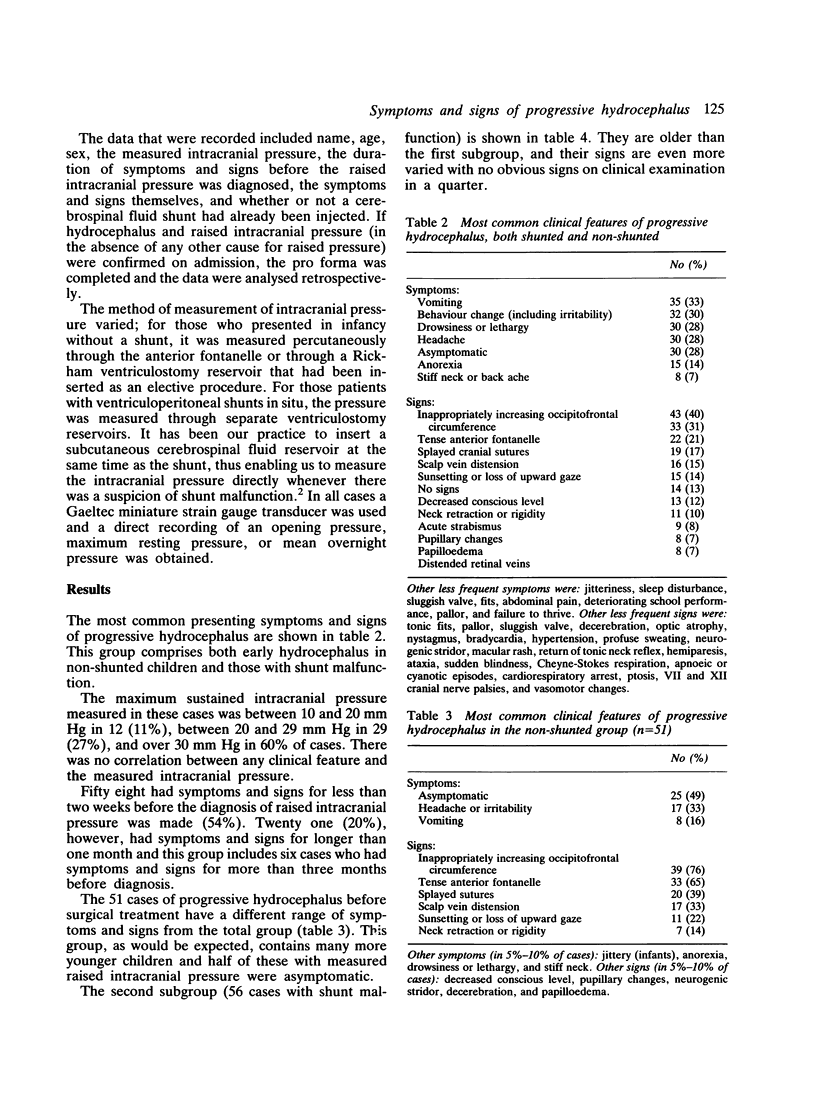Abstract
The clinical features of 107 cases of children with hydrocephalus and measured raised intraventricular pressure were analysed retrospectively. Fifty one children had recently been diagnosed as having hydrocephalus, and the remainder had had shunts injected to direct the cerebrospinal fluid. The most common symptoms in the group were vomiting, behavioural changes, drowsiness, and headaches. The most common clinical signs were inappropriately increasing occipitofrontal head circumferences, tense anterior fontanelles, splayed sutures, and distension of the scalp veins. Half the infantile cases of hydrocephalus were without symptoms, and a quarter of the cases with cerebrospinal fluid shunts and measured raised intraventricular pressure were without signs. There were no fewer than 33 different clinical signs including several unusual ones, such as macular rash and sweating. We believe that the presentation of hydrocephalus with raised intraventricular pressure is sufficiently variable, unusual, or even absent to justify the direct measurement of intracranial pressure.
Full text
PDF




Selected References
These references are in PubMed. This may not be the complete list of references from this article.
- Adeloye A., Singh S. P., Odeku E. L. Stridor, myelomeningocele, and hydrocephalus in a child. Arch Neurol. 1970 Sep;23(3):271–273. doi: 10.1001/archneur.1970.00480270081011. [DOI] [PubMed] [Google Scholar]
- Boltshauser E., Hirsig J., Isler W., Rickham P. P. Hemiparesis--an uncommon symptom of hydrocephalus or shunt dysfunction. Z Kinderchir Grenzgeb. 1980 Jul;30(3):191–197. doi: 10.1055/s-2008-1066360. [DOI] [PubMed] [Google Scholar]
- Chattha A. S., Delong G. R. Sylvian aqueduct syndrome as a sign of acute obstructive hydrocephalus in children. J Neurol Neurosurg Psychiatry. 1975 Mar;38(3):288–296. doi: 10.1136/jnnp.38.3.288. [DOI] [PMC free article] [PubMed] [Google Scholar]
- Ducker T. B. Increased intracranial pressure and pulmonary edema. 1. Clinical study of 11 patients. J Neurosurg. 1968 Feb;28(2):112–117. doi: 10.3171/jns.1968.28.2.0112. [DOI] [PubMed] [Google Scholar]
- Fiedler R., Krieger D. T. Endocrine disturbances in patients with congenital aqueductal stenosis. Acta Endocrinol (Copenh) 1975 Sep;80(1):1–13. doi: 10.1530/acta.0.0800001. [DOI] [PubMed] [Google Scholar]
- Hagberg B., Sjorgen I. The chronic brain syndrome of infantile hydrocephalus. A follow-up study of 63 spontaneously arrested cases. Am J Dis Child. 1966 Sep;112(3):189–196. doi: 10.1001/archpedi.1966.02090120057004. [DOI] [PubMed] [Google Scholar]
- Hier D. B., Wiehl A. C. Chronic hydrocephalus associated with short stature and growth hormone deficiency. Ann Neurol. 1977 Sep;2(3):246–248. doi: 10.1002/ana.410020312. [DOI] [PubMed] [Google Scholar]
- Kim C. S., Bennett D. R., Roberts T. S. Primary amenorrhea secondary to noncommunicating hydrocephalus. Case report. Neurology. 1969 Jun;19(6):533–535. doi: 10.1212/wnl.19.6.533. [DOI] [PubMed] [Google Scholar]
- Leggate J. R., Baxter P., Minns R. A., Steers A. J., Brown J. K., Shaw J. F., Elton R. A. Role of a separate subcutaneous cerebro-spinal fluid reservoir in the management of hydrocephalus. Br J Neurosurg. 1988;2(3):327–337. doi: 10.3109/02688698809001003. [DOI] [PubMed] [Google Scholar]
- Lonton A. P. The relationship between intellectual skills and the computerised axial tomograms of children with spina bifida and hydrocephalus. Z Kinderchir Grenzgeb. 1979 Dec;28(4):368–374. [PubMed] [Google Scholar]
- Summers G. D., Young A. C., Little R. A., Stoner H. B., Forbes W. S., Jones R. A. Spontaneous periodic hypothermia with lipoma of the corpus callosum. J Neurol Neurosurg Psychiatry. 1981 Dec;44(12):1094–1099. doi: 10.1136/jnnp.44.12.1094. [DOI] [PMC free article] [PubMed] [Google Scholar]
- TADROS F. W., SEROUR O. H., ZAKI S. A., SAKR R. The so-called general symptoms of increased intracranial pressure. Clinico-pathological report based on a study of 100 cases. Postgrad Med J. 1962 Jul;38:417–426. doi: 10.1136/pgmj.38.441.417. [DOI] [PMC free article] [PubMed] [Google Scholar]
- Tomasovic J. A., Nellhaus G., Moe P. G. The bobble-head doll syndrome: an early sign of hydrocephalus. Two new cases and a review of the literature. Dev Med Child Neurol. 1975 Dec;17(6):777–783. doi: 10.1111/j.1469-8749.1975.tb04702.x. [DOI] [PubMed] [Google Scholar]


